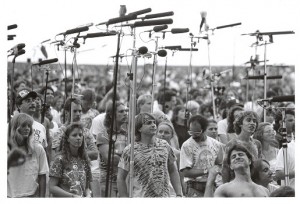My recent posts have touched on endangered analog audio formats (open reel tape and compact cassette) and the challenges involved in digitizing and preserving them. For this installment, we’ll enter the dawn of the digital and Internet age and take a look at the first widely available consumer digital audio format: the DAT (Digital Audio Tape).
The DAT was developed by consumer electronics juggernaut Sony and introduced to the public in 1987. While similar in appearance to the familiar cassette and also utilizing magnetic tape, the DAT was slightly smaller and only recorded on one “side.” It boasted lossless digital encoding at 16 bits and variable sampling rates maxing out at 48 kHz–better than the 44.1 kHz offered by Compact Discs. During the window of time before affordable hard disk recording (roughly, the 1990s), the DAT ruled the world of digital audio.
The format was quickly adopted by the music recording industry, allowing for a fully digital signal path through the recording, mixing, and mastering stages of CD production. Due to its portability and sound quality, DAT was also enthusiastically embraced by field recordists, oral historians & interviewers, and live music recordists (AKA “tapers”):
 [Conway, Michael A., “Deadheads in the Taper’s section at an outside venue,” Grateful Dead Archive Online, accessed October 10, 2014, http://www.gdao.org/items/show/834556.]
[Conway, Michael A., “Deadheads in the Taper’s section at an outside venue,” Grateful Dead Archive Online, accessed October 10, 2014, http://www.gdao.org/items/show/834556.]
However, the format never caught on with the public at large, partially due to the cost of the players and the fact that few albums of commercial music were issued on DAT [bonus trivia question: what was the first popular music recording to be released on DAT? see below for answer]. In fact, the recording industry actively sought to suppress public availability of the format, believing that the ability to make perfect digital copies of CDs would lead to widespread piracy and bootlegging of their product. The Recording Industry Association of America (RIAA) lobbied against the DAT format and attempted to impose restrictions and copyright detection technology on the players. Once again (much like the earlier brouhaha over cassette tapes and subsequent battle over mp3’s and file sharing) “home taping” was supposedly killing music.
By the turn of the millennium, CD burning technology had become fairly ubiquitous and hard disk recording was becoming more affordable and portable. The DAT format slowly faded into obscurity, and in 2005, Sony discontinued production of DAT players.
In 2014, we are left with a decade’s worth of primary source audio tape (oral histories, interviews, concert and event recordings) that is quickly degrading and may soon be unsalvageable. The playback decks (and parts for them) are no longer produced and there are few technicians with the knowledge or will to repair and maintain them. The short-term answer to these problems is to begin stockpiling working DAT machines and doing the slow work of digitizing and archiving the tapes one by one. For example, the Libraries’ Jazz Loft Project Records collection consisted mainly of DAT tapes, and now exists as digital files accessible through the online finding aid: http://library.duke.edu/rubenstein/findingaids/jazzloftproject/. A long-term approach calls for a survey of library collections to identify the number and condition of DAT tapes, and then for prioritization of these items as it may be logistically impossible to digitize them all.
And now, the answer to our trivia question: in May 1988, post-punk icons Wire released The Ideal Copy on DAT, making it the first popular music recording to be issued on the new format.



